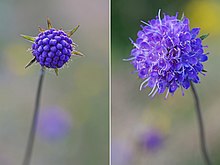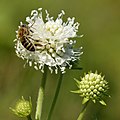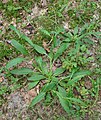Succisa pratensis
| Succisa pratensis | |
|---|---|

| |
| Scientific classification | |
| Kingdom: | Plantae |
| Clade: | Tracheophytes |
| Clade: | Angiosperms |
| Clade: | Eudicots |
| Clade: | Asterids |
| Order: | Dipsacales |
| Family: | Caprifoliaceae |
| Genus: | Succisa |
| Species: | S. pratensis
|
| Binomial name | |
| Succisa pratensis | |
| Synonyms[1] | |
|
List
| |
Succisa pratensis, also known as devil's-bit or devil's-bit scabious, is a
Name
Species of scabious were used to treat
Description
Succisa pratensis is a
Distribution
Succisa pratensis is common throughout most of the British Isles,[10] western and central Europe, extending eastwards into central Asia. It is absent from eastern Asia.[13] It has been introduced to eastern North America.[14]
Ecology
It grows in wet or dry grassland and heath on acid or basic soils[10] and is found in hedgerows, marshes, meadows and pastures.[15]
The flowers are visited by various types of insects, but especially frequently by hoverflies of the genus Eristalis.[16] It is a good source of nectar and is the larval food plant of the marsh fritillary,[17] the eggs of which are laid in groups on the underside of the plant, and the narrow-bordered bee hawk-moth (Hemaris tityus). As both invertebrates are rare,[18][19] their survival relies on careful management of sites containing these plant and butterfly species.
It is parasitized by the chytrid fungus Synchytrium succisae.[20]
Management
This section needs additional citations for verification. (November 2018) |
The aim is to produce an uneven patchwork of short and long vegetation by the end of the grazing period, between 8 and 25 cm (3.1 and 9.8 in). This is to allow the devil's bit scabious food plant to grow.
This can be achieved through low intensity grazing (also known as extensive grazing) using cattle. Sheep are not so good as they are more efficient at removing wild plants.
Gallery
-
Bloom
-
Succisa pratensis on the German island Hiddensee
-
White-flowered form with the honey bee
-
Foliage in situ showing leaf arrangement
-
Closeup
-
Underside
-
Flower bud
References
- ^ "Succisa pratensis Moench". Plants of the World Online. Board of Trustees of the Royal Botanic Gardens, Kew. 2017. Retrieved 23 September 2020.
- ^ Wild Flowers of Britain and Ireland by Rae Spencer Jones and Sarah Cuttle
- ^ The Illustrated Wild Flower Finder's Calendar
- ^ Kingfisher Field Guides - Wild Flowers of Britain and Northern Europe
- ^ The I-Spy Guide to Wild Flowers by Michelin
- ^ Wild Flowers of Britain by Roger Phillips
- ^ Wild Flowers of Britain and Ireland by Marjorie Blamey, Richard Fitter, Alastair Fitter
- ISBN 978-1845337315.
- ^ Usborne Spotter's Handbook of Birds, Trees, Wildflowers
- ^ ISBN 9780521707725.
- ^ A photographic guide to Wildflowers of Britain and Europe by Paul Sterry and Bob Press
- ISBN 0521232902.
- ^ Anderberg, Arne. "Succisa pratensis Moench Sw". Naturhistoriska riksmuseet, Stockholm.
- ^ USDA, NRCS (n.d.). "Succisa pratensis". The PLANTS Database (plants.usda.gov). Greensboro, North Carolina: National Plant Data Team. Retrieved 4 December 2015.
- ISBN 9780521046565
- PMID 25754608.
- ISBN 0-7232-1499-9
- ^ Searle, Mark. "Marsh Fritillary". butterfly-conservation.org. Retrieved 9 September 2018.
- ^ Gor, Adam. "Narrow-bordered Bee Hawk-moth". Butterfly Conservation. Retrieved 9 September 2018.
- ^ Karling, J.S. 1964. Synchytrium.Academic Press: New York.
External links
 Data related to Succisa pratensis at Wikispecies
Data related to Succisa pratensis at Wikispecies- The Plant Press Natural England Website







